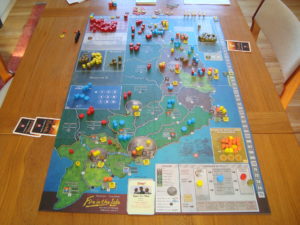Tim sent me his (always trenchant) comments. Here they are:
- I was curious about how much population is contained in city spaces (14). In light of this weekend’s games, a good strategy for the US is to focus on pacifying the cities (14 x 2= 28) and keeping the commitment low (you had 22 available troops), as it is hard for the insurgent player to counter. I had trouble moving guerrillas into the cities and keeping them alive…
- A good counter to the above strategy is to kill off US troops. I didn’t do a very good job of hunting them down (and you were good about not putting them in exposed positions). I had hoped to run some bombardment operations but either my troops were in the wrong place or I had to do something else…
- Another possible counter is the one I stumbled upon in the last game: the VC wins the hearts and minds of the countryside and just enough of the cities to get the win.
- I was surprised at how the lack of resources really hampers the insurgent player. I got a little frustrated during the first game because it seemed just when the NVA was ready to intervene, you would play an event card to either reduce or eliminate their resources.
- The ARVN and VC were much more active in this weekend’s games than in our earlier games, which were dominated by the US and the NVA. The VC ability to subvert enemy troops makes them fun to play (you showed admirable forbearance in the face of my constant cries of ‘terror and subvert’….). The ARVN troops gave me trouble in the second game and played a big role in holding the line until you could bring your airstrikes to bear.
- I missed a trick when I didn’t move the NVA troops into provinces that supported you. I know you would have bombed them anyway, but the price would have been higher.
- Did you know that NVA troops can be used for terror operations? I didn’t notice that until midway through the second game (there is a lot of nuance in this game). I wonder if it would be a good idea for the NVA to send in small groups of troops for terror ops and maybe picking off the occasional enemy unit.
- Did you know that NVA guerrillas can set up in the south? For some reason, I’d gotten it in my head that they couldn’t.
- I kept too many units back to defend bases. I probably should have pushed more units forward into the fray…I think it wouldn’t be a bad idea to put more than one base in area so as to cut down on the numbers of defenders.
